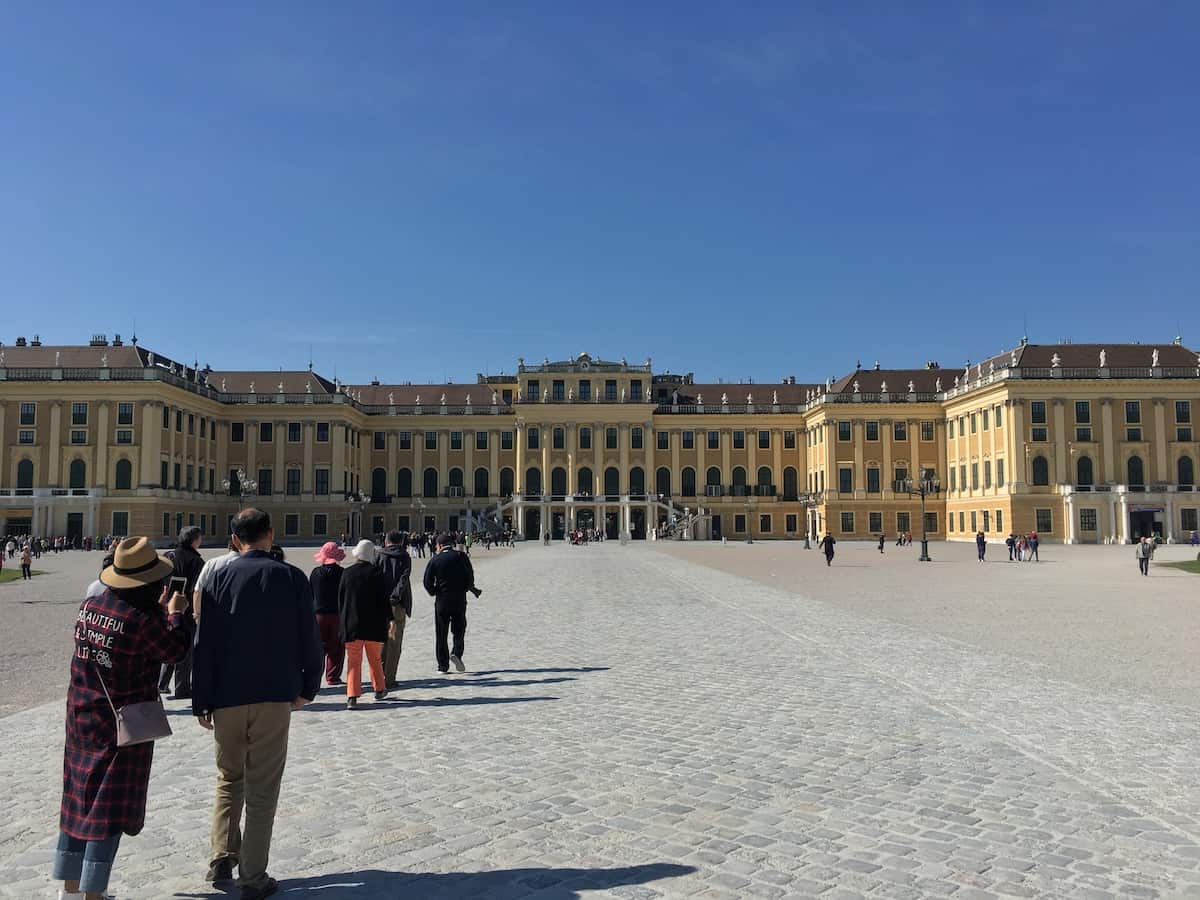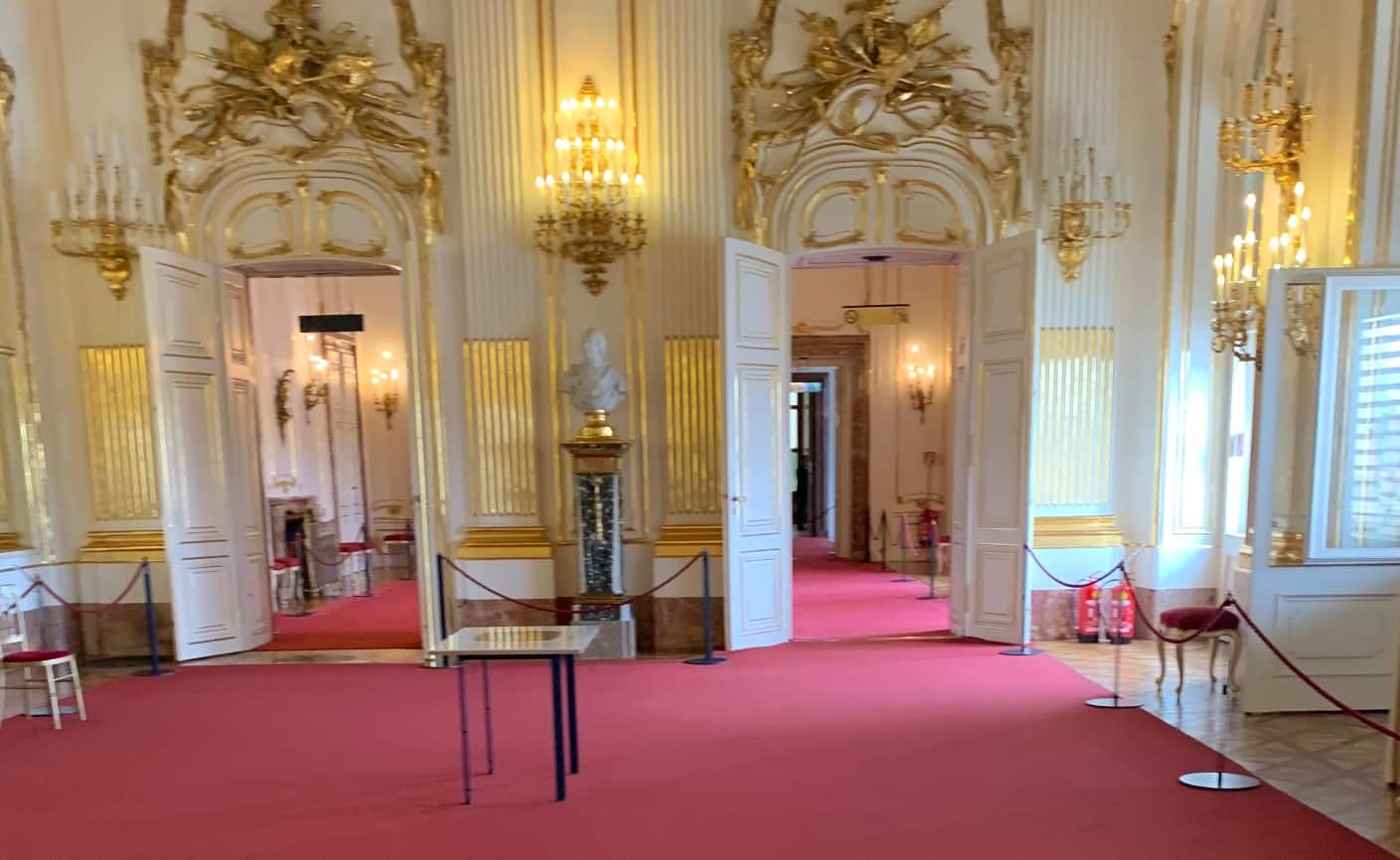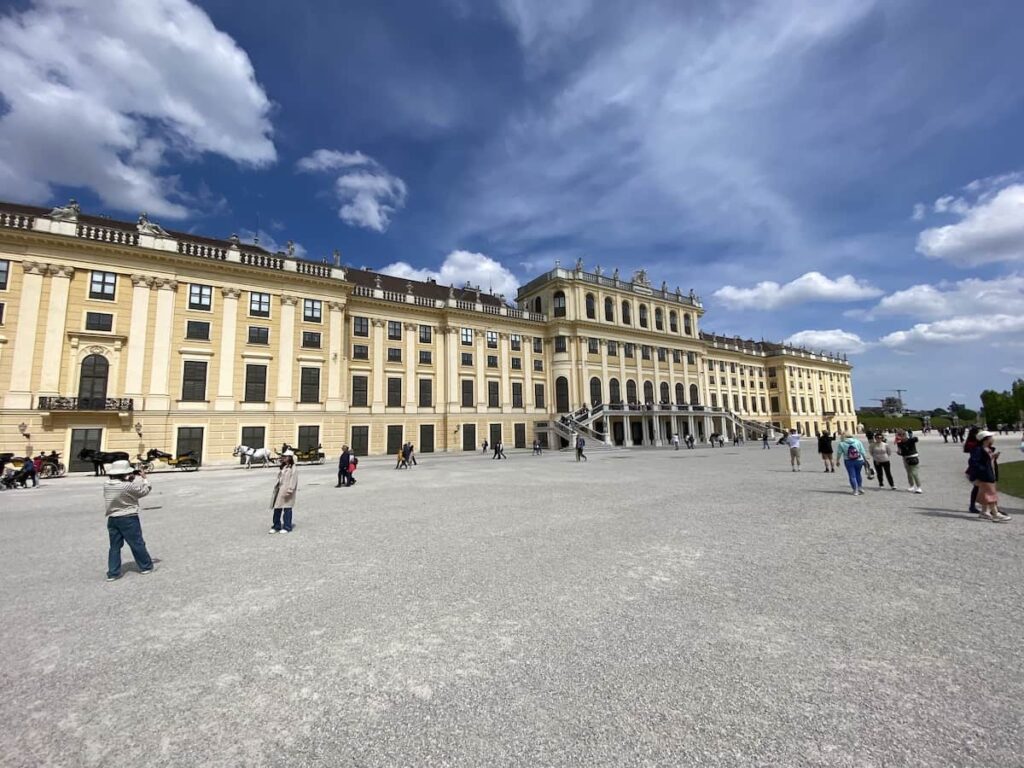Once surrounded by untouched nature, the summer palace of the Habsburgs now stands at the western edge of Vienna’s historic center. What was once a royal retreat has become one of Austria’s most visited landmarks. Despite the city expanding around it, Palace Schönbrunn has retained its grandeur, surrounded by beautifully landscaped gardens and parkland.
Originally built in the early 18th century, the palace underwent a major transformation under Empress Maria Theresa, also known as Sisi. It was during her reign that Schönbrunn took on the opulent appearance that still captivates visitors today.
A masterpiece of symmetry and splendor

One of the most striking features of Schloss Schönbrunn is its perfect symmetry. From the grand entrance courtyard to the palace façade, every architectural detail is meticulously balanced, reflecting the Habsburgs’ love for order and elegance.
Inside, the palace boasts an astonishing 1,441 rooms, but only 40 are open to the public. Among them are the sumptuous state rooms, lavishly decorated in gold, chandeliers, and intricate frescoes. The tour also takes you through more private living quarters, where the grandeur gives way to a more modest, yet still refined, aesthetic.
Palace Schönbrunn A must-see in Vienna
Schönbrunn Palace is undoubtedly one of the top attractions in Vienna, earning its place on any must-visit list. Despite the crowds and tour buses that flock to this iconic site daily, it remains an unforgettable experience.
From its imperial history to its breathtaking architecture and gardens, a visit to Schloss Schönbrunn is a journey back in time—one that showcases the grandeur of the Habsburg dynasty like no other place in Vienna.
When is the best time to visit Schönbrunn Palace?
Schönbrunn Palace is the most visited attraction in Vienna and even in all of Austria. As a result, it is crowded every day, especially during the summer months. To avoid large crowds, it is recommended to visit as early as possible. The palace gates open early in the morning, and entry tickets are now sold with timed slots.
It is best to arrive before 9:00 AM to get ahead of the busloads of tourists and to have more time to explore the Schönbrunn grounds, including the Tiergarten (zoo) and the beautiful gardens.
Another reason to visit early in the summer is the temperature. As a UNESCO World Heritage site, Schönbrunn Palace cannot undergo modern modifications, meaning there is no air conditioning or climate control inside. Many windows also cannot be opened for security reasons, making it uncomfortably warm inside on hot summer days.
The 1,441 rooms of Schönbrunn Palace

The rooms in Schönbrunn Palace are predominantly decorated in the Rococo style, which was highly popular during the time of Empress Sisi and Emperor Franz Joseph. This style is characterized by plush fabrics, carpets, soft pastel colors, silk wall coverings, and large paintings. The Habsburg dynasty was immensely wealthy, and they took every opportunity to showcase their wealth and status. Most walls and ceilings in Schönbrunn Palace are lacquered white with gold leaf accents, designed to impress nobles and aristocrats visiting the summer residence.
During a guided tour, visitors can explore various rooms, including private chambers and workspaces. The tour also passes by one of the many bathrooms and the beauty salon of Sisi and Marie Antoinette. Despite the palace housing 1,441 rooms, only 40 rooms are accessible to the public. Guides provide insights into the history of each room, and visitors are welcome to ask questions.
Wolfgang Amadeus Mozart
Some of the most historically significant rooms include:
- The Hall of Mirrors, where a six-year-old Wolfgang Amadeus Mozart performed a concert for Empress Maria Theresa in 1762.
- The Great Gallery, where a grand ball was held in 1815 to celebrate the conclusion of the Congress of Vienna, which redrew the political map of Europe.
- The various living and reception rooms, decorated with exotic tropical scenes, including palm trees and animals from distant lands.
The vast and stunning Schönbrunn gardens
Behind the palace, a magnificent park spans one square kilometre. This landscaped masterpiece is one of Schönbrunn’s most remarkable features and was opened to the public at the end of the 18th century. Surrounding the central Neptune Fountain, visitors will find beautiful flower beds, water features, and additional fountains, all designed in the French garden style.
The botanical garden and the orangery have a Dutch connection—this section was designed by Dutch landscape architect Adrian van Steckhoven, assisted by Richard van der Schot. Van Steckhoven was responsible for bringing the Maria Theresa Palm Tree to Vienna, managing to cultivate it in Vienna’s much colder climate.
The park also features a maze, as well as several notable structures, including the Gloriette. This open colonnade, situated on a hill, provides a stunning backdrop to the gardens. Designed by architect Hetzendorf, the Gloriette serves as a grand architectural conclusion to the park. Other highlights include the Roman Ruin, also designed by Hetzendorf, accompanied by an obelisk and a fountain.
Visit the impressive summer palace of the imperial family

Take a look inside Schönbrunn Palace. Visit the rooms where the Emperor and Empress once lived. Admire the splendour of the Habsburgs and experience the world of Sisi.
With a guide, you will explore all the remarkable rooms and receive detailed explanations.
“Skip the line” – Your guide has already purchased the tickets, saving you a long wait at the ticket counter.
The Palm house and gardens of Schönbrunn Palace
Another significant structure within the palace grounds is the Palm House, a massive tropical greenhouse measuring 25 meters high, 111 meters long, and 28 meters wide. Inside, visitors can admire a diverse collection of exotic plants and flowers from all over the world. The construction of the Palm House was commissioned by Emperor Franz Joseph I, who had a deep fascination with exotic flora.
This passion also led to the creation of the Desert House, which showcases various cacti species from Australia and South Africa. During his reign, Franz Joseph also initiated the construction of a zoo around a pavilion where he used to have breakfast. Today, this pavilion has been converted into a restaurant.
Comparing the main tours at Schönbrunn Palace
Visiting Schönbrunn Palace isn’t a one-size-fits-all experience. Whether you’re short on time or eager to explore every imperial detail, there’s a tour that fits your style. Here’s a closer look at four of the main options:
1. Palace Ticket – The full experience at your pace
This self-guided tour provides you with access to all 40 rooms of the palace’s piano nobile, the main floor once reserved for the imperial family and their guests. With an audio guide in hand, you’ll move through the intimate private apartments of Emperor Franz Joseph and Empress Elisabeth, as well as the grand reception rooms that overlook the gardens. The Rococo interiors from Maria Theresa’s time, decorated with rare East Asian features, offer a vivid picture of life at court. Expect to spend around an hour soaking up centuries of history.
2. State Apartments – A compact tour of imperial splendour
Short on time but still want a sense of imperial grandeur? The State Apartments tour focuses on the highlights—about 22 of the most lavish rooms, including the Great Gallery, the Hall of Ceremonies and the richly adorned Chinese Cabinets. It’s a 40-minute walkthrough that captures the essence of court life under Maria Theresa, perfect for first-time visitors who want a taste of Schönbrunn without committing to a full hour.
3. Guided Tour Maria Theresia – A deeper dive into the empress’s world
This guided tour is ideal for visitors with a specific interest in Maria Theresa, one of Austria’s most influential rulers. In 75 minutes, a knowledgeable guide takes you beyond the highlights and into the world of an empress who ruled for four decades. You’ll start in her summer apartments, decorated with vibrant murals of exotic landscapes, before heading upstairs to explore the opulent state rooms and more intimate family spaces on the piano nobile. It’s a tour that not only shows you the palace, but tells a story.
4. Sisi Ticket – Follow in the footsteps of empress Elisabeth
This ticket is more than just a palace visit—it’s a journey through the life of Empress Elisabeth, better known as Sisi. It includes entry to 40 rooms at Schönbrunn Palace with an audio guide, and continues into central Vienna with access to the Sisi Museum and the former imperial apartments at the Hofburg. To round out the experience, you’ll also visit the Vienna Furniture Museum, where the “Sisi in the Movies” exhibition adds a pop-culture twist to her legacy. This ticket is perfect for those who want to go beyond the palace walls and explore the myth and reality of Austria’s most famous empress.
Our tip? Go all in
If it’s your first time in Vienna—or even if it’s your only time—we always recommend choosing either the full Palace Ticket or the Guided Tour Maria Theresia. Schönbrunn isn’t just another historic site; it’s a place where the story of Austria unfolds room by room. Since chances are you might not return anytime soon, give yourself the chance to experience the full imperial atmosphere in one go. You won’t regret it.
Admission prices in 2025
Below is an overview of the current admission prices for Schönbrunn Palace (as of April 1, 2025).
| Ticket type | Adults | Children (6-18 years) |
|---|---|---|
| Palace ticket (approx. 60 minutes) | €34.00 | €24.00 |
| State Apartments (approx. 40 minutes) | €25.00 | €16.00 |
| Guided tour Maria Theresia (approx. 75 minutes) | €39.00 | €29.00 |
| Sis Pass (3 locations) | €51.00 | €33,50 |
I highly recommend booking the Grand Tour, as it provides the most comprehensive and impressive experience of Schönbrunn Palace.
Opening hours for 2025
Schönbrunn Palace is open year-round, including on public holidays and Christmas. However, opening hours vary by season. Please refer to the table below for details.
| Date | Opening hours |
|---|---|
| July 1, 2025 – August 31, 2025 | 8:30 AM – 6:00 PM |
| September 1, 2025 – november 2, 2025 | 8:30 AM – 5:30 PM |
| November 3, 2025 – March 26, 2026 | 8:30 AM – 5:00 PM |
Visitors can enter until 45 minutes before closing time. More details about opening hours can be found on the official Schönbrunn Palace website.
How to get to Schönbrunn Palace?
There are several transportation options to reach the palace. Below is a quick overview:
| Transport | Stop | Walking distance |
|---|---|---|
| U-Bahn/Metro | Line U4 – Schönbrunn Station | 5 minutes |
| Tram | Line 10 or 60 – Schönbrunn Stop | 8 minutes |
| Bus | Line 10A – Schönbrunn Stop | 8 minutes |
| Sightseeing Bus | All Hop-On Hop-Off buses stop at Schönbrunn Station | — |
Practical information
Name: Schloss Schönbrunn
Location: Schönbrunner Schloßstraße 47, 1130 Vienna
Opening hours: daily from 8.30 closing time depending on season
Admission fee: Tickets start from € 24.00
Tickets: Online booking recommended – check tickets and availability
Public transport: Metro U4 station Schönbrunn or Hietzing + all hop on hop off buses
Suitable for children: Yes
Best time to visit: Early in the morning
Also visit the beautiful gardens and the oldest Zoo of Europe
Frequently Asked Questions about Schönbrunn Palace
Still missing an answer to your question? Let us know!
Can I visit a classical concert at the Palace Schönbrunn ?
Yes, you can; it’s even possible in combination with a dinner. After a guided tour with an audio guide, you end the evening with a luxurious dinner in the restaurant. Then, you move to the Orangerie, where you can enjoy a classical concert.
Is Schönbrunn accessible for strollers and wheelchairs?
Can I also eat and drink at Schönbrunn?
In the ticket office, there is a café with an extensive (perhaps somewhat expensive) menu. About 15 minutes from the palace, there is a very good pastry shop with reasonable prices and a cosy guest garden. Near the entrance of the palace, you can also find a bakery where you can attend the live strudel show.
Is the entrance included with a Vienna Pass?
Yes, with the Vienna Pass, you can visit Schönbrunn Palace for free. With the Vienna City Card, you get a discount of about 10% on the entrance fees.
